warning Alfa Romeo GT 2006 Owner handbook (in English)
[x] Cancel search | Manufacturer: ALFA ROMEO, Model Year: 2006, Model line: GT, Model: Alfa Romeo GT 2006Pages: 307, PDF Size: 6.05 MB
Page 126 of 307
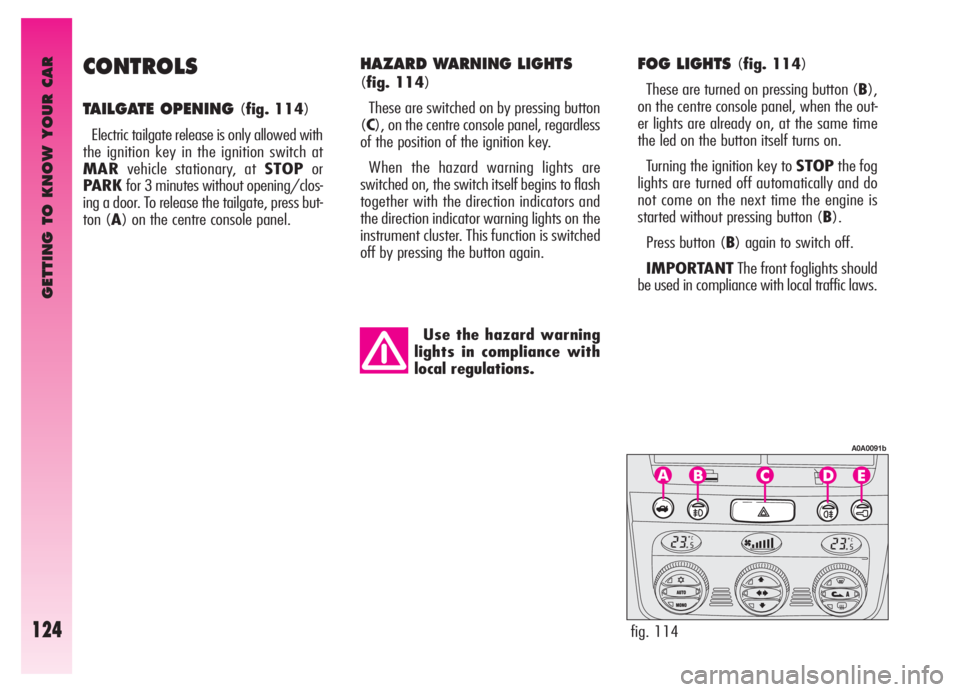
GETTING TO KNOW YOUR CAR
124
CONTROLS
TAILGATE OPENING (fig. 114)
Electric tailgate release is only allowed with
the ignition key in the ignition switch at
MARvehicle stationary, at STOPor
PARK for 3 minutes without opening/clos-
ing a door. To release the tailgate, press but-
ton (A) on the centre console panel.
Use the hazard warning
lights in compliance with
local regulations.
FOG LIGHTS (fig. 114)
These are turned on pressing button (B),
on the centre console panel, when the out-
er lights are already on, at the same time
the led on the button itself turns on.
Turning the ignition key to STOPthe fog
lights are turned off automatically and do
not come on the next time the engine is
started without pressing button (B).
Press button (B) again to switch off.
IMPORTANTThe front foglights should
be used in compliance with local traffic laws.
fig. 114
A0A0091b
HAZARD WARNING LIGHTS
(fig. 114)
These are switched on by pressing button
(C), on the centre console panel, regardless
of the position of the ignition key.
When the hazard warning lights are
switched on, the switch itself begins to flash
together with the direction indicators and
the direction indicator warning lights on the
instrument cluster. This function is switched
off by pressing the button again.
Page 127 of 307
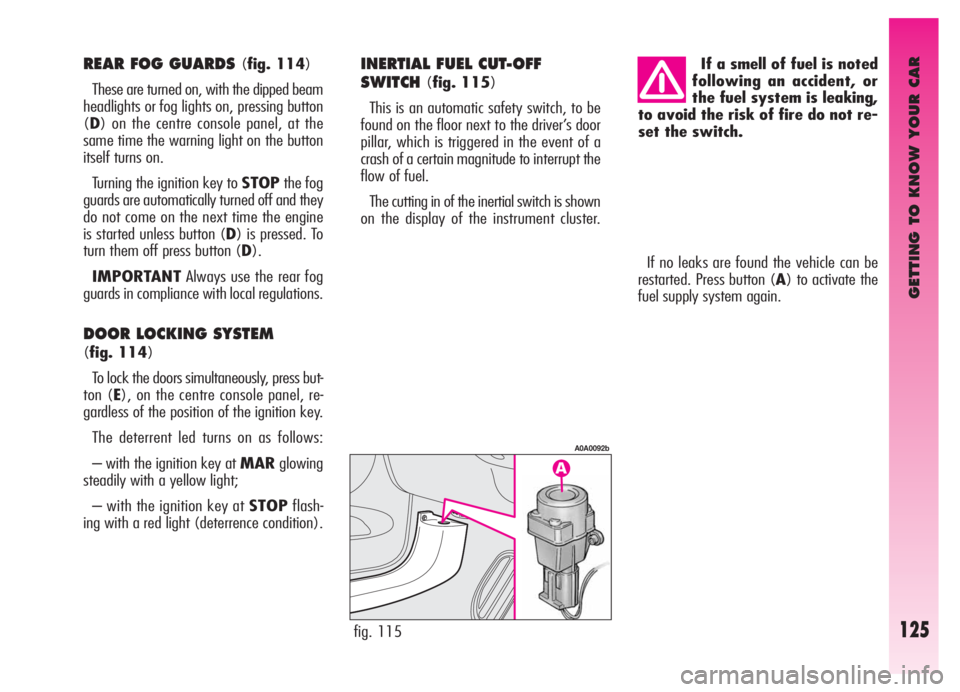
GETTING TO KNOW YOUR CAR
125
If no leaks are found the vehicle can be
restarted. Press button (A) to activate the
fuel supply system again.
fig. 115
A0A0092b
If a smell of fuel is noted
following an accident, or
the fuel system is leaking,
to avoid the risk of fire do not re-
set the switch.REAR FOG GUARDS (fig. 114)
These are turned on, with the dipped beam
headlights or fog lights on, pressing button
(D) on the centre console panel, at the
same time the warning light on the button
itself turns on.
Turning the ignition key to STOPthe fog
guards are automatically turned off and they
do not come on the next time the engine
is started unless button (D) is pressed. To
turn them off press button (D).
IMPORTANTAlways use the rear fog
guards in compliance with local regulations.
DOOR LOCKING SYSTEM
(fig. 114)
To lock the doors simultaneously, press but-
ton (E), on the centre console panel, re-
gardless of the position of the ignition key.
The deterrent led turns on as follows:
– with the ignition key at MARglowing
steadily with a yellow light;
– with the ignition key at STOPflash-
ing with a red light (deterrence condition).
INERTIAL FUEL CUT-OFF
SWITCH
(fig. 115)
This is an automatic safety switch, to be
found on the floor next to the driver’s door
pillar, which is triggered in the event of a
crash of a certain magnitude to interrupt the
flow of fuel.
The cutting in of the inertial switch is shown
on the display of the instrument cluster.
Page 128 of 307

GETTING TO KNOW YOUR CAR
126
The adjustment of Xenon headlights is au-
tomatic, therefore the versions fitted with
this optional lack the headlight aiming de-
vice (fig. 116a).
HAND BRAKE(fig. 117)
The hand brake lever is located between
the two front seats.
To operate the brake when the vehicle is
stationary, pull lever (A) upwards, until the
required braking action is obtained.
When the ignition key is at MAR, the
warning light on the instrument cluster
x
will come on.
fig. 117
A0A0620b
fig. 116a versions with Xenon headlights
A0A0677b
Adjust the beams every
time the load carried
changes.
For correct adjustment, bear in mind the
following conditions:
– position 0: one or two people occupy-
ing the the front seats
– position 1: five people;
– position 2: five people + load in the
boot;
– position 3: driver + maximum permis-
sible load all stowed in lug-
gage compartment
fig. 116 versions without Xenon headlights
A0A0093b
HEADLIGHT AIMING DEVICE
(fig. 116)
The headlights should be aimed correctly
depending on the vehicle load.
To do this, use the rocker button (A), on
the plate at the side of the steering column:
– press the arrow on the button (
A), to
increase by one position (e.g.:0
➟1➟2➟
3);
– press the arrow on the button (
S), to lower
by one position (e.g.:3
➟2➟1➟0);
The display (B) in the tachometer shows the
positions during adjustment.
Page 129 of 307

GETTING TO KNOW YOUR CAR
127
To release the hand brake:
– slightly lift the lever (A) and press the
release button (B);
– keeping the button pressed lower the
lever, the warning light
xon the instru-
ment cluster will go out.
To prevent the car from moving acciden-
tally, keep the brake pedal pressed when
engaging the hand brake.
IMPORTANTThe hand brake lever (A)
is fitted with a safety device which prevents
the brake from being released when, with
the lever pulled, button (B) is pressed.
Therefore, to release the brake, in addition
to pressing button (B), it is also necessary
to pull lever (A) further upwards to release
the safety device, then lower the lever com-
pletely.
IMPORTANTOn certain versions a
buzzer sounds to alert the driver if the car
is moved with the hand brake engaged.
GEARSHIFT LEVER (fig. 118)
The position of the single gears is shown
by the pictogram on the gearshift lever
knob.
When shifting gear, always fully depress
the clutch pedal. Before engaging reverse
gear (R) wait for the car to be stationary.
Certain versions are fitted with 6-gear gear-
box.
IMPORTANTReverse gear may only be
engaged with the car completely at a stand-
still. With the engine running, before en-
gaging reverse gear it is necessary to wait
for at least 3 seconds with the clutch pedal
fully depressed to prevent clashing and the
possibility of damaging the gears. The wheels should be
locked after a few clicks of
the hand brake. If it does
not occur contact Alfa Romeo Au-
thorised Services to have the hand
brake adjusted.To change gear smoothly,
the clutch pedal must be
fully depressed. Therefore,
there should be no obstacles on the
floor under the pedal unit: make
sure that any mats are well laid
and do not interfere with the ped-
als.
fig. 118
A0A0684b
Page 131 of 307
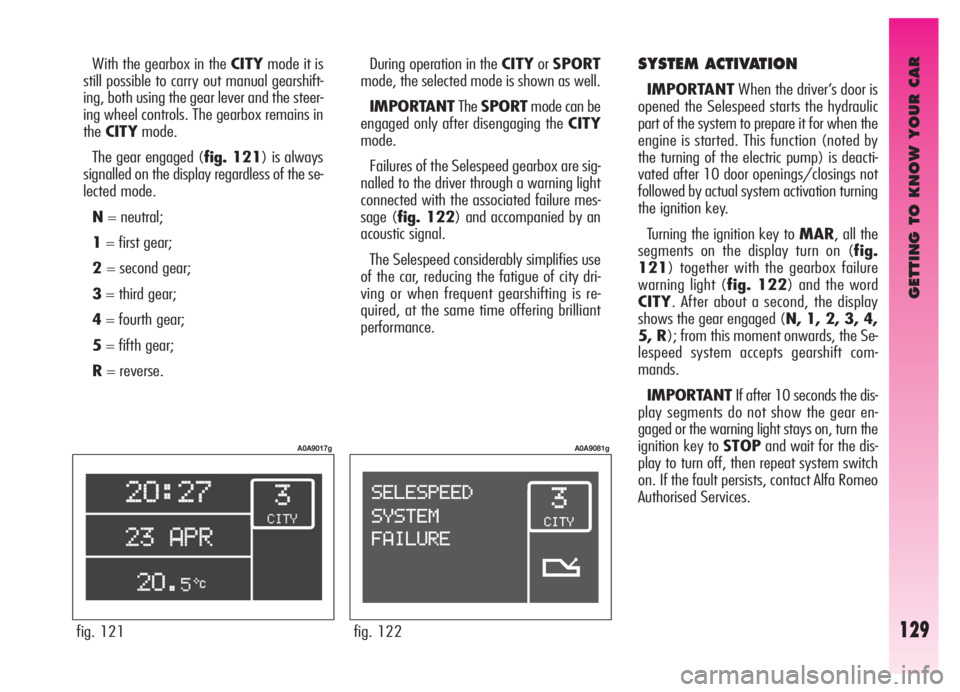
GETTING TO KNOW YOUR CAR
129
SYSTEM ACTIVATION
IMPORTANTWhen the driver’s door is
opened the Selespeed starts the hydraulic
part of the system to prepare it for when the
engine is started. This function (noted by
the turning of the electric pump) is deacti-
vated after 10 door openings/closings not
followed by actual system activation turning
the ignition key.
Turning the ignition key to MAR, all the
segments on the display turn on (fig.
121) together with the gearbox failure
warning light (fig. 122) and the word
CITY. After about a second, the display
shows the gear engaged (N, 1, 2, 3, 4,
5, R); from this moment onwards, the Se-
lespeed system accepts gearshift com-
mands.
IMPORTANTIf after 10 seconds the dis-
play segments do not show the gear en-
gaged or the warning light stays on, turn the
ignition key to STOPand wait for the dis-
play to turn off, then repeat system switch
on. If the fault persists, contact Alfa Romeo
Authorised Services. With the gearbox in the CITYmode it is
still possible to carry out manual gearshift-
ing, both using the gear lever and the steer-
ing wheel controls. The gearbox remains in
theCITYmode.
The gear engaged (fig. 121) is always
signalled on the display regardless of the se-
lected mode.
N= neutral;
1= first gear;
2= second gear;
3= third gear;
4= fourth gear;
5= fifth gear;
R= reverse.During operation in the CITYorSPORT
mode, the selected mode is shown as well.
IMPORTANTTheSPORTmode can be
engaged only after disengaging the CITY
mode.
Failures of the Selespeed gearbox are sig-
nalled to the driver through a warning light
connected with the associated failure mes-
sage (fig. 122) and accompanied by an
acoustic signal.
The Selespeed considerably simplifies use
of the car, reducing the fatigue of city dri-
ving or when frequent gearshifting is re-
quired, at the same time offering brilliant
performance.
fig. 121
A0A9017g
fig. 122
A0A9081g
Page 138 of 307
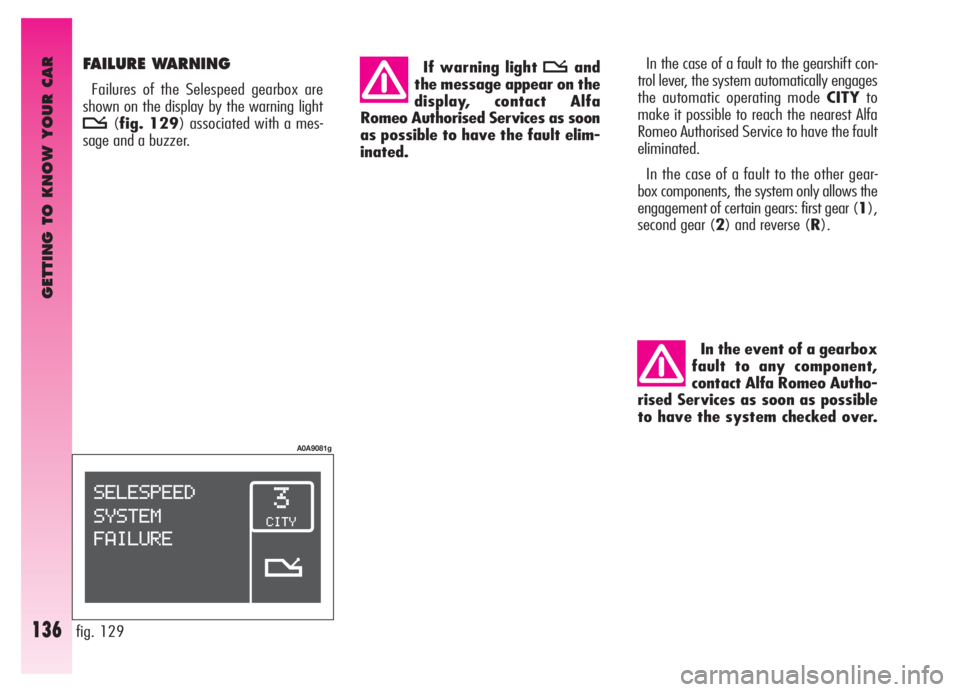
In the event of a gearbox
fault to any component,
contact Alfa Romeo Autho-
rised Services as soon as possible
to have the system checked over.In the case of a fault to the gearshift con-
trol lever, the system automatically engages
the automatic operating mode CITYto
make it possible to reach the nearest Alfa
Romeo Authorised Service to have the fault
eliminated.
In the case of a fault to the other gear-
box components, the system only allows the
engagement of certain gears: first gear (1),
second gear (2) and reverse (R).
GETTING TO KNOW YOUR CAR
136
FAILURE WARNING
Failures of the Selespeed gearbox are
shown on the display by the warning light
t(fig. 129) associated with a mes-
sage and a buzzer. If warning light
tand
the message appear on the
display, contact Alfa
Romeo Authorised Services as soon
as possible to have the fault elim-
inated.
fig. 129
A0A9081g
Page 139 of 307
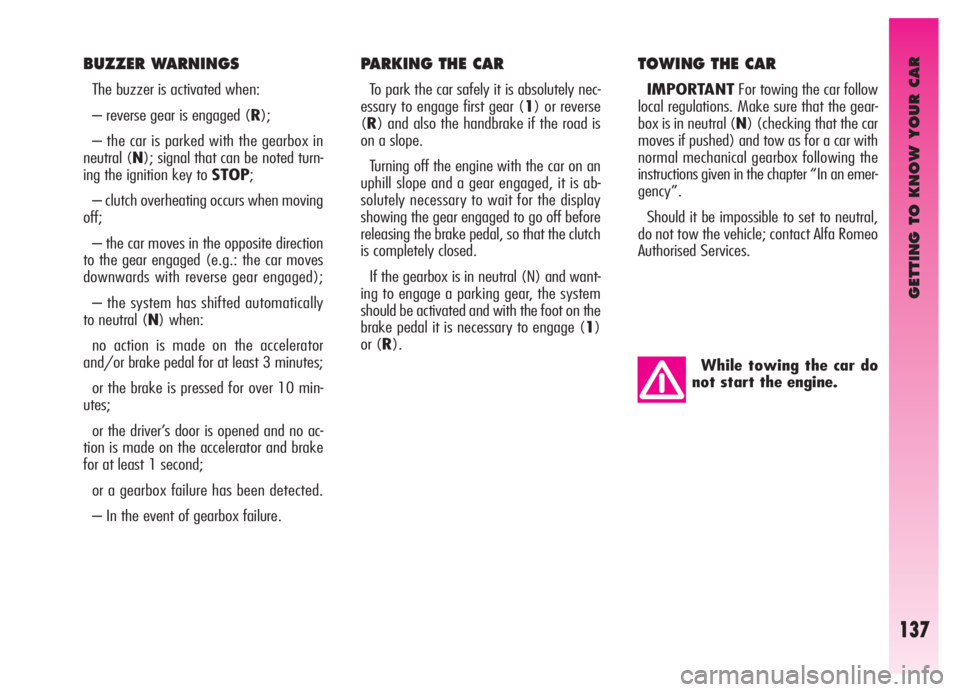
GETTING TO KNOW YOUR CAR
137
PARKING THE CAR
To park the car safely it is absolutely nec-
essary to engage first gear (1) or reverse
(R) and also the handbrake if the road is
on a slope.
Turning off the engine with the car on an
uphill slope and a gear engaged, it is ab-
solutely necessary to wait for the display
showing the gear engaged to go off before
releasing the brake pedal, so that the clutch
is completely closed.
If the gearbox is in neutral (N) and want-
ing to engage a parking gear, the system
should be activated and with the foot on the
brake pedal it is necessary to engage (1)
or (R).
TOWING THE CAR
IMPORTANTFor towing the car follow
local regulations. Make sure that the gear-
box is in neutral (N) (checking that the car
moves if pushed) and tow as for a car with
normal mechanical gearbox following the
instructions given in the chapter “In an emer-
gency”.
Should it be impossible to set to neutral,
do not tow the vehicle; contact Alfa Romeo
Authorised Services.
While towing the car do
not start the engine.
BUZZER WARNINGS
The buzzer is activated when:
– reverse gear is engaged (R);
– the car is parked with the gearbox in
neutral (N); signal that can be noted turn-
ing the ignition key to STOP;
– clutch overheating occurs when moving
off;
– the car moves in the opposite direction
to the gear engaged (e.g.: the car moves
downwards with reverse gear engaged);
– the system has shifted automatically
to neutral (N) when:
no action is made on the accelerator
and/or brake pedal for at least 3 minutes;
or the brake is pressed for over 10 min-
utes;
or the driver’s door is opened and no ac-
tion is made on the accelerator and brake
for at least 1 second;
or a gearbox failure has been detected.
– In the event of gearbox failure.
Page 147 of 307

GETTING TO KNOW YOUR CAR
145
OPENING FROM INSIDE
(fig. 143)
Tailgate is released electrically and this can
be performed only when the ignition key
is in position MARwith car at a standstill
or in STOPorPARKposition for 3 min-
utes without unlocking/locking one of the
doors.
To unlock the tailgate, press button (A)
on the centre console panel.
Tailgate raising is facilitated by the gas
shock springs.
OPENING WITH REMOTE
CONTROL
(fig. 144)
The tailgate can be opened by remote con-
trol from outside pressing the button (A),
also when the electronic alarm is engaged.
Opening of the tailgate is accompanied by
a double flash of the direction indicators;
closing is accompanied by a single flash.
If an electronic alarm is fitted, with the
opening of the tailgate, the alarm system
switches off volumetric protection and the
tailgate control sensor, the system “beeps”
twice (with the exception of certain mar-
kets).
Closing the tailgate again, the control func-
tions are restored, the system “beeps” twice
(with the exception of certain markets).
fig. 143
A0A0129b
LUGGAGE
COMPARTMENT
The tailgate can be opened:
from the outside of the car- by a
remote control impulse;
from the inside of the door- by de-
pressing the button (A-fig. 143).
IMPORTANTIf the boot is not proper-
ly shut, the
´warning light will come on
(on certain versions accompanied by the
message on the reconfigurable multifunction
display).
The gas springs are cali-
brated to ensure correct
tailgate raising with the
weights foreseen by the manufac-
turer. The arbitrary addition of
items (such spoilers, etc.) may
compromise the correct operation
and safety of the actual tailgate.
fig. 144
A0A0636b
Page 152 of 307

GETTING TO KNOW YOUR CAR
150
ABS
(upon request for
versions/markets where
provided)
The car is fitted with an ABS braking sys-
tem, which prevents the wheels from lock-
ing when braking, makes full use of the grip
and within the limits of the grip available,
keeps the car controllable also in emergency
braking.
When braking a slight pulsing accompa-
nied by noise may be felt on the brake ped-
al due to the action of the ABS system.
This should not be interpreted as a brak-
ing malfunction. It is the signal to the driver
that the ABS has come into action: it is the
warning that the car is travelling at the lim-
it of its grip and therefore the speed should
be adapted to the type of road.
The ABS system is an additional part of the
base braking system; in the event of a fail-
ure it is disabled, leaving the braking sys-
tem in the same conditions as a vehicle with-
out ABS.The ABS better exploits
the grip available, but can-
not increase it; caution is
therefore necessary on slippery
surfaces, without taking unneces-
sary risks.
If the ABS cuts in it means
that the limit of the grip is
being reached between the
tyre and the road surface: it is
therefore necessary to slow down
to adapt driving to the grip avail-
able.
In the event of a system
failure, with the turning on
of the
>warning light on
the instrument cluster, have the car
checked immediately by Alfa
Romeo Authorised Services, to be
able to have the system restored
to fully efficient conditions.
In the case of a failure, the anti-lock action
is no longer present, the braking capacity of
the vehicle is not adversely affected at all.
If you have never previously used cars fit-
ted with ABS, it is advisable to practice a lit-
tle on a slippery surface, naturally in safe-
ty conditions and in accordance with the lo-
cal Highway Code; you are also advised to
read the following instructions carefully.
The advantage of the ABS over a conven-
tional system is that it makes it possible to
obtain the highest degree of handling also
when braking completely under limited grip
conditions, preventing the wheels from lock-
ing.
However, with the ABS do not expect the
braking distance to always shorten: for ex-
ample, on soft surfaces like gravel or fresh
snow or a slippery surface, the space might
increase.
To better exploit the possibilities of the an-
ti-lock system in the case of need, the ad-
vice given below should be followed.
Page 153 of 307

GETTING TO KNOW YOUR CAR
151
Always take due care when braking on
bends, even with the help of the ABS.
The most important advice of all, howev-
er, is this:
When the ABS cuts in, and
you feel the pulsing on the
pedal, do not lighten the
pressure, but keep the pedal firm-
ly pressed with no fear; this way
you will stop in the least space
possible, compatibly with the con-
ditions of the road surface.
Following these instructions you will be
in the best braking condition under all cir-
cumstances.
IMPORTANTCars fitted with ABS may
only be fitted with the wheel rims, tyres and
brake linings of type and brand approved by
the Manufacturer.
The system is completed by the EBD (Elec-
tronic Brake Distributor) which distributes
the braking action through the control unit
and the ABS system sensors.The car is fitted with an
electronic braking distribu-
tor (EBD). If the
>andx
warning lights turn on simultane-
ously with the engine running, this
indicates an EBD system failure; in
this case with sharp braking the
rear wheels might lock too early,
with the possibility of skidding.
Driving extremely carefully, go to
the nearest Alfa Romeo Authorised
Service to have the system
checked.
The turning on of only the
>warning light with the
engine running normally in-
dicates a fault to the ABS system
only. In this case the braking sys-
tem is still efficient, though with-
out the aid of the anti-lock device.
Under these conditions perfor-
mance of the EBD system may be
reduced. In this case too, you are
advised to go immediately to the
nearest Alfa Romeo Authorised
Service to have the system checked
over, driving in such a way as to
avoid sharp braking.
If the low brake fluid lev-
el
xwarning light turns
on, stop the car immedi-
ately and contact the nearest Alfa
Romeo Authorised Service. Any
loss of fluid from the hydraulic sys-
tem will negatively affect the op-
eration of the braking system be it
of the conventional type or of the
type with ABS.
If the compact spare wheel
is used, operation of the
ABS system is cut off and
the
>warning light on the instru-
ment cluster turns on.
IMPORTANTIf the battery is run down
the
>andxwarning lights might turn
on when starting the engine and go off af-
ter starting. This should not be considered
as a fault but as a warning that during start-
ing the ABS is not active. The turning off
of the warning lights ensures normal system
operation.